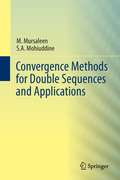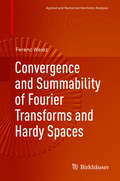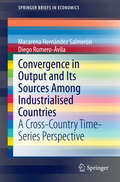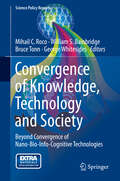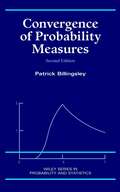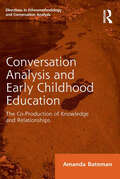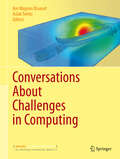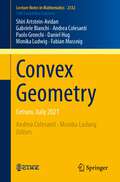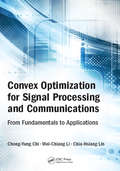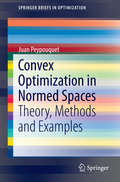- Table View
- List View
Convergence Methods for Double Sequences and Applications
by M. Mursaleen S. A. MohiuddineThis book exclusively deals with the study of almost convergence and statistical convergence of double sequences. The notion of "almost convergence" is perhaps the most useful notion in order to obtain a weak limit of a bounded non-convergent sequence. There is another notion of convergence known as the "statistical convergence", introduced by H. Fast, which is an extension of the usual concept of sequential limits. This concept arises as an example of "convergence in density" which is also studied as a summability method. Even unbounded sequences can be dealt with by using this method. The book also discusses the applications of these non-matrix methods in approximation theory. Written in a self-contained style, the book discusses in detail the methods of almost convergence and statistical convergence for double sequences along with applications and suitable examples. The last chapter is devoted to the study convergence of double series and describes various convergence tests analogous to those of single sequences. In addition to applications in approximation theory, the results are expected to find application in many other areas of pure and applied mathematics such as mathematical analysis, probability, fixed point theory and statistics.
Convergence and Summability of Fourier Transforms and Hardy Spaces (Applied and Numerical Harmonic Analysis)
by Ferenc WeiszThe main purpose is to investigate the convergence and summability both of one-dimensional and multi-dimensional Fourier transforms as well as the theory of Hardy spaces. A general summability method, the so called theta-summation, is studied which contains all well known summability methods, such as the Fej#65533;r, Riesz, Weierstrass, Abel, Picard, Bessel and Rogosinski summations. After the classical books of Bary (1964) and Zygmund (1968), this is the first book which considers strong summability treated by current methods. A further novelty of this book is that the Lebesgue points are studied also in the theory of multi-dimensional summability. Besides the classical results, recent results of the last 20-30 years are studied. These results can be found in different research papers the summary of which in a unified context provides the readers a valuable support in their work. The book will be useful for researchers as well as for graduate or postgraduate students. The first two chapters can be used by graduate students and the other ones by PhD students and researchers.
Convergence in Output and Its Sources Among Industrialised Countries: A Cross-Country Time-Series Perspective (SpringerBriefs in Economics)
by Diego Romero-Ávila Macarena Hernández SalmerónThis book investigates the existence of stochastic and deterministic convergence of real output per worker and the sources of output (physical capital per worker, human capital per worker, total factor productivity -TFP- and average annual hours worked) in 21 OECD countries over the period 1970-2011. Towards this end, the authors apply a large battery of panel unit root and stationarity tests, all of which are robust to the presence of cross-sectional dependence. The evidence fails to provide clear-cut evidence of convergence dynamics either in real GDP per worker or in the series of the sources of output. Due to some limitations associated with second-generation panel unit root and stationarity tests, the authors further use the more flexible PANIC approach which provides evidence that real GDP per worker, real physical capital per worker, human capital and average annual hours exhibit some degree of deterministic convergence, whereas TFP series display a high degree of stochastic convergence.
Convergence of Knowledge, Technology and Society: Beyond Convergence of Nano-Bio-Info-Cognitive Technologies (Science Policy Reports)
by Mihail C. Roco William S. Bainbridge Bruce Tonn George WhitesidesThis volume aims to document the most important worldwide accomplishments in converging knowledge and technology, including converging platforms, methods of convergence, societal implications, and governance in the last ten years. Convergence in knowledge, technology, and society is the accelerating, transformative interaction among seemingly distinct scientific disciplines, technologies, and communities to achieve mutual compatibility, synergism, and integration, and through this process to create added value for societal benefit. It is a movement that is recognized by scientists and thought leaders around the world as having the potential to provide far-reaching solutions to many of today's complex knowledge, technology, and human development challenges. Four essential and interdependent convergence platforms of human activity are defined in the first part of this report: nanotechnology-biotechnology-information technology and cognitive science ("NBIC") foundational tools; Earth-scale environmental systems; human-scale activities; and convergence methods for societal-scale activities. The report then presents the main implications of convergence for human physical potential, cognition and communication, productivity and societal outcomes, education and physical infrastructure, sustainability, and innovative and responsible governance. As a whole, the report presents a new model for convergence. To effectively take advantage of this potential, a proactive governance approach is suggested. The study identifies an international opportunity to develop and apply convergence for technological, economic, environmental, and societal benefits. The panel also suggests an opportunity in the United States for implementing a program aimed at focusing disparate R and D energies into a coherent activity - a "Societal Convergence Initiative". This study received input from leading academic, industry, government, and NGO experts from the United States, Latin America, Europe, Asia, and Australia.
Convergence of One-Parameter Operator Semigroups
by Adam BobrowskiThis book presents a detailed and contemporary account of the classical theory of convergence of semigroups and its more recent development treating the case where the limit semigroup, in contrast to the approximating semigroups, acts merely on a subspace of the original Banach space (this is the case, for example, with singular perturbations). The author demonstrates the far-reaching applications of this theory using real examples from various branches of pure and applied mathematics, with a particular emphasis on mathematical biology. The book may serve as a useful reference, containing a significant number of new results ranging from the analysis of fish populations to signaling pathways in living cells. It comprises many short chapters, which allows readers to pick and choose those topics most relevant to them, and it contains 160 end-of-chapter exercises so that readers can test their understanding of the material as they go along.
Convergence of Probability Measures
by Patrick BillingsleyA new look at weak-convergence methods in metric spaces-from a master of probability theory In this new edition, Patrick Billingsley updates his classic work Convergence of Probability Measures to reflect developments of the past thirty years. Widely known for his straightforward approach and reader-friendly style, Dr. Billingsley presents a clear, precise, up-to-date account of probability limit theory in metric spaces. He incorporates many examples and applications that illustrate the power and utility of this theory in a range of disciplines-from analysis and number theory to statistics, engineering, economics, and population biology. With an emphasis on the simplicity of the mathematics and smooth transitions between topics, the Second Edition boasts major revisions of the sections on dependent random variables as well as new sections on relative measure, on lacunary trigonometric series, and on the Poisson-Dirichlet distribution as a description of the long cycles in permutations and the large divisors of integers. Assuming only standard measure-theoretic probability and metric-space topology, Convergence of Probability Measures provides statisticians and mathematicians with basic tools of probability theory as well as a springboard to the "industrial-strength" literature available today.
Conversation Analysis and Early Childhood Education: The Co-Production of Knowledge and Relationships (Directions in Ethnomethodology and Conversation Analysis)
by Amanda BatemanThis book provides insight into the everyday activities co-produced by teachers and young children, demonstrating the fine details of teaching and learning as knowledge is shared through the everyday activities of talk-in-interaction. Adopting an ethnomethodological perspective, together with conversation analysis and membership categorisation analysis, it reveals how teaching and learning are jointly accomplished during activities such as pretend play episodes, during disputes, managing illness and talking about the environment. Through in-depth studies of child-teacher interactions, the book explores the means by which knowledge is transferred and episodes of teaching and learning are co-constructed by participants, shedding light on the co-production of social order, the communication of knowledge and manner in which professional and relational identities are made relevant in interaction. As such, Conversation Analysis and Early Childhood Education will be of interest not only to scholars of ethnomethodology and conversation analysis, but also to those working in the areas of early childhood studies and pedagogy.
Conversations About Challenges in Computing
by Aslak Tveito Are Magnus BruasetThis text sheds light on how mathematical models and computing can help understanding and prediction of complicated physical processes; how communication networks should be designed and implemented to meet the increasingly challenging requirements from users; and how modern engineering principles can lead to better and more robust software systems. Through interviews with 12 internationally recognized researchers within these fields, conducted by the well-known science writer Dana Mackenzie and the science journalist Kathrine Aspaas, the reader gets views on recent achievements and future challenges.
Conversations on Optimal Transport
by Luigi Ambrosio Alfio QuarteroniThis work is closely tied to the renowned mathematics textbook series known as UNITEXT, tailored for university students pursuing bachelor’s or master’s degrees. What sets this particular book apart in the Springer collection is its unique origin: it has been crafted through a meticulous process involving interviews handled with and by world-class mathematicians. The content featured in this book revolve around a highly relevant and engaging topic: Optimal Transport. These conversations involve not only authors from the UNITEXT series, but also members of the series’ Editorial Board. Additionally, they feature prominent figures in the field, including a Field Medalist. This work provides readers with a snapshot of remarkable vitality and freshness, guaranteed to captivate and engage anyone with an interest in mathematics. It’s important to note that these interviews were initially shared as podcasts and originally broadcasted as online events on the Cassyni platform. Subsequently, advanced AI tools were employed under human supervision to transcribe the audios and edit them for better readability. A human copy-editor was involved during the whole process, and the authors revised the final copy-edited texts before publication. The content in each format – the interviews, the PODCASTS and the book – is self-contained and not a mere adaptation from one medium to another. Instead, it represents an independent exploration of the subject matter.
Conversations on Social Choice and Welfare Theory - Vol. 1 (Studies in Choice and Welfare)
by Marc Fleurbaey Maurice SallesThis volume presents interviews that have been conducted from the 1980s to the present with important scholars of social choice and welfare theory. Starting with a brief history of social choice and welfare theory written by the book editors, it features 15 conversations with four Nobel Laureates and other key scholars in the discipline. The volume is divided into two parts. The first part presents four conversations with the founding fathers of modern social choice and welfare theory: Kenneth Arrow, John Harsanyi, Paul Samuelson, and Amartya Sen. The second part includes conversations with scholars who made important contributions to the discipline from the early 1970s onwards. This book will appeal to anyone interested in the history of economics, and the history of social choice and welfare theory in particular.
Converting Data into Evidence: A Statistics Primer for the Medical Practitioner
by Alfred Demaris Steven H. SelmanConverting Data into Evidence: A Statistics Primer for the Medical Practitioner provides a thorough introduction to the key statistical techniques that medical practitioners encounter throughout their professional careers. These techniques play an important part in evidence-based medicine or EBM. Adherence to EBM requires medical practitioners to keep abreast of the results of medical research as reported in their general and specialty journals. At the heart of this research is the science of statistics. It is through statistical techniques that researchers are able to discern the patterns in the data that tell a clinical story worth reporting. The authors begin by discussing samples and populations, issues involved in causality and causal inference, and ways of describing data. They then proceed through the major inferential techniques of hypothesis testing and estimation, providing examples of univariate and bivariate tests. The coverage then moves to statistical modeling, including linear and logistic regression and survival analysis. In a final chapter, a user-friendly introduction to some newer, cutting-edge, regression techniques will be included, such as fixed-effects regression and growth-curve modeling. A unique feature of the work is the extensive presentation of statistical applications from recent medical literature. Over 30 different articles are explicated herein, taken from such journals. With the aid of this primer, the medical researcher will also find it easier to communicate with the statisticians on his or her research team. The book includes a glossary of statistical terms for easy access. This is an important reference work for the shelves of physicians, nurses, nurse practitioners, physician's assistants, medical students, and residents.
Convex Analysis (Textbooks in Mathematics #21)
by Steven G. KrantzThe book showcases convexity in the context of mathematical analysis. It introduces analytic tools for studying convexity and provides analytical applications of the concept. The book includes a general background in classical geometric theory which allows readers to obtain a glimpse of how modern mathematics is developed and how geometric ideas may be studied analytically. Featuring a user-friendly approach, the book contains copious examples and plenty of figures to illustrate the ideas presented. It also includes a thorough glossary to help readers with unfamiliar terms.
Convex Analysis and Global Optimization (Springer Optimization and Its Applications #110)
by Hoang TuyThisbook presents state-of-the-art results and methodologies in modern globaloptimization, and has been a staple reference for researchers, engineers, advancedstudents (also in applied mathematics), and practitioners in various fields ofengineering. The second edition has been brought up to date and continues todevelop a coherent and rigorous theory of deterministic global optimization,highlighting the essential role of convex analysis. The text has been revisedand expanded to meet the needs of research, education, and applications for manyyears to come. Updates forthis new edition include: #65533; Discussion of modern approaches to minimax, fixed point, andequilibrium theorems, and to nonconvex optimization; #65533; Increased focus on dealing more efficiently with ill-posedproblems of global optimization, particularly those with hard constraints; #65533; Important discussions of decomposition methods for speciallystructured problems; #65533; A complete revision of the chapter on nonconvex quadraticprogramming, in order to encompass the advances made in quadratic optimizationsince publication of the first edition. #65533; Additionally, this new edition contains entirely new chaptersdevoted to monotonic optimization, polynomial optimization and optimization underequilibrium constraints, including bilevel programming, multiobjectiveprogramming, and optimization with variational inequality constraint. From thereviews of the first edition: The book gives a good review of the topic. . . . The text iscarefully constructed and well written, the exposition is clear. It leaves aremarkable impression of the concepts, tools and techniques in globaloptimization. It might also be used as a basis and guideline for lectures onthis subject. Students as well as professionals will profitably read and useit. --Mathematical Methods of OperationsResearch, 49:3 (1999)
Convex Analysis and Monotone Operator Theory in Hilbert Spaces (CMS Books in Mathematics)
by Heinz H. Bauschke Patrick L. CombettesThis reference text, now in its second edition, offers a modern unifying presentation of three basic areas of nonlinear analysis: convex analysis, monotone operator theory, and the fixed point theory of nonexpansive operators. Taking a unique comprehensive approach, the theory is developed from the ground up, with the rich connections and interactions between the areas as the central focus, and it is illustrated by a large number of examples. The Hilbert space setting of the material offers a wide range of applications while avoiding the technical difficulties of general Banach spaces. The authors have also drawn upon recent advances and modern tools to simplify the proofs of key results making the book more accessible to a broader range of scholars and users. Combining a strong emphasis on applications with exceptionally lucid writing and an abundance of exercises, this text is of great value to a large audience including pure and applied mathematicians as well as researchers in engineering, data science, machine learning, physics, decision sciences, economics, and inverse problems. The second edition of Convex Analysis and Monotone Operator Theory in Hilbert Spaces greatly expands on the first edition, containing over 140 pages of new material, over 270 new results, and more than 100 new exercises. It features a new chapter on proximity operators including two sections on proximity operators of matrix functions, in addition to several new sections distributed throughout the original chapters. Many existing results have been improved, and the list of references has been updated.Heinz H. Bauschke is a Full Professor of Mathematics at the Kelowna campus of the University of British Columbia, Canada.Patrick L. Combettes, IEEE Fellow, was on the faculty of the City University of New York and of Université Pierre et Marie Curie – Paris 6 before joining North Carolina State University as a Distinguished Professor of Mathematics in 2016.
Convex Analysis for Optimization: A Unified Approach (Graduate Texts in Operations Research)
by Jan BrinkhuisThis textbook offers graduate students a concise introduction to the classic notions of convex optimization. Written in a highly accessible style and including numerous examples and illustrations, it presents everything readers need to know about convexity and convex optimization. The book introduces a systematic three-step method for doing everything, which can be summarized as "conify, work, deconify". It starts with the concept of convex sets, their primal description, constructions, topological properties and dual description, and then moves on to convex functions and the fundamental principles of convex optimization and their use in the complete analysis of convex optimization problems by means of a systematic four-step method. Lastly, it includes chapters on alternative formulations of optimality conditions and on illustrations of their use."The author deals with the delicate subjects in a precise yet light-minded spirit... For experts in the field, this book not only offers a unifying view, but also opens a door to new discoveries in convexity and optimization...perfectly suited for classroom teaching." Shuzhong Zhang, Professor of Industrial and Systems Engineering, University of Minnesota
Convex Bodies: The Brunn-Minkowski Theory
by Rolf SchneiderAt the heart of this monograph is the Brunn-Minkowski theory, which can be used to great effect in studying such ideas as volume and surface area and their generalizations. In particular, the notions of mixed volume and mixed area measure arise naturally and the fundamental inequalities that are satisfied by mixed volumes are considered here in detail. The author presents a comprehensive introduction to convex bodies, including full proofs for some deeper theorems. The book provides hints and pointers to connections with other fields and an exhaustive reference list. This second edition has been considerably expanded to reflect the rapid developments of the past two decades. It includes new chapters on valuations on convex bodies, on extensions like the Lp Brunn-Minkowski theory, and on affine constructions and inequalities. There are also many supplements and updates to the original chapters, and a substantial expansion of chapter notes and references.
Convex Duality and Financial Mathematics (SpringerBriefs in Mathematics)
by Peter Carr Qiji Jim ZhuThis book provides a concise introduction to convex duality in financial mathematics. Convex duality plays an essential role in dealing with financial problems and involves maximizing concave utility functions and minimizing convex risk measures. Recently, convex and generalized convex dualities have shown to be crucial in the process of the dynamic hedging of contingent claims. Common underlying principles and connections between different perspectives are developed; results are illustrated through graphs and explained heuristically. This book can be used as a reference and is aimed toward graduate students, researchers and practitioners in mathematics, finance, economics, and optimization. Topics include: Markowitz portfolio theory, growth portfolio theory, fundamental theorem of asset pricing emphasizing the duality between utility optimization and pricing by martingale measures, risk measures and its dual representation, hedging and super-hedging and its relationship with linear programming duality and the duality relationship in dynamic hedging of contingent claims
Convex Functions and Their Applications: A Contemporary Approach (CMS Books in Mathematics)
by Constantin P. Niculescu Lars-Erik PerssonThorough introduction to an important area of mathematics Contains recent results Includes many exercises
Convex Functions and Their Applications: A Contemporary Approach (CMS/CAIMS Books in Mathematics #14)
by Constantin P. Niculescu Lars-Erik PerssonThis third edition presents an expanded and updated treatment of convex analysis methods, incorporating many new results that have emerged in recent years. These additions are essential for grasping the practical applications of convex function theory in solving contemporary real-world problems. To reflect these advancements, the material has been meticulously reorganized, with a greater emphasis on topics relevant to current research. Additionally, great care has been taken to ensure that the text remains accessible to a broad audience, including both students and researchers focused on the application of mathematics. Ideal for undergraduate courses, graduate seminars, or as a comprehensive reference, this book is an indispensable resource for those seeking to understand the extensive potential of convex function theory.
Convex Functions: Constructions, Characterizations and Counterexamples
by Jonathan M. Borwein Jon D. VanderwerffLike differentiability, convexity is a natural and powerful property of functions that plays a significant role in many areas of mathematics, both pure and applied. It ties together notions from topology, algebra, geometry and analysis, and is an important tool in optimization, mathematical programming and game theory. This 2010 book, which is the product of a collaboration of over 15 years, is unique in that it focuses on convex functions themselves, rather than on convex analysis. The authors explore the various classes and their characteristics and applications, treating convex functions in both Euclidean and Banach spaces. The book can either be read sequentially for a graduate course, or dipped into by researchers and practitioners. Each chapter contains a variety of specific examples, and over 600 exercises are included, ranging in difficulty from early graduate to research level.
Convex Geometry: Cetraro, Italy 2021 (Lecture Notes in Mathematics #2332)
by Monika Ludwig Gabriele Bianchi Andrea Colesanti Paolo Gronchi Daniel Hug Shiri Artstein-Avidan Fabian MussnigThis book collects the lecture notes of the Summer School on Convex Geometry, held in Cetraro, Italy, from August 30th to September 3rd, 2021.Convex geometry is a very active area in mathematics with a solid tradition and a promising future. Its main objects of study are convex bodies, that is, compact and convex subsets of n-dimensional Euclidean space. The so-called Brunn--Minkowski theory currently represents the central part of convex geometry.The Summer School provided an introduction to various aspects of convex geometry: The theory of valuations, including its recent developments concerning valuations on function spaces; geometric and analytic inequalities, including those which come from the Lp Brunn--Minkowski theory; geometric and analytic notions of duality, along with their interplay with mass transportation and concentration phenomena; symmetrizations, which provide one of the main tools to many variational problems (not only in convex geometry). Each of these parts is represented by one of the courses given during the Summer School and corresponds to one of the chapters of the present volume. The initial chapter contains some basic notions in convex geometry, which form a common background for the subsequent chapters.The material of this book is essentially self-contained and, like the Summer School, is addressed to PhD and post-doctoral students and to all researchers approaching convex geometry for the first time.
Convex Optimization
by Stephen Boyd Lieven VandenbergheConvex optimization problems arise frequently in many different fields. A comprehensive introduction to the subject, this book shows in detail how such problems can be solved numerically with great efficiency. The focus is on recognizing convex optimization problems and then finding the most appropriate technique for solving them. The text contains many worked examples and homework exercises and will appeal to students, researchers and practitioners in fields such as engineering, computer science, mathematics, statistics, finance, and economics.
Convex Optimization for Signal Processing and Communications: From Fundamentals to Applications
by Chong-Yung Chi Wei-Chiang Li Chia-Hsiang LinConvex Optimization for Signal Processing and Communications: From Fundamentals to Applications provides fundamental background knowledge of convex optimization, while striking a balance between mathematical theory and applications in signal processing and communications. In addition to comprehensive proofs and perspective interpretations for core convex optimization theory, this book also provides many insightful figures, remarks, illustrative examples, and guided journeys from theory to cutting-edge research explorations, for efficient and in-depth learning, especially for engineering students and professionals. With the powerful convex optimization theory and tools, this book provides you with a new degree of freedom and the capability of solving challenging real-world scientific and engineering problems.
Convex Optimization in Normed Spaces: Theory, Methods and Examples (SpringerBriefs in Optimization #0)
by Juan PeypouquetThis work is intended to serve as a guide for graduate students and researchers who wish to get acquainted with the main theoretical and practical tools for the numerical minimization of convex functions on Hilbert spaces. Therefore, it contains the main tools that are necessary to conduct independent research on the topic. It is also a concise, easy-to-follow and self-contained textbook, which may be useful for any researcher working on related fields, as well as teachers giving graduate-level courses on the topic. It will contain a thorough revision of the extant literature including both classical and state-of-the-art references.
Convex Optimization of Power Systems
by Joshua Adam TaylorOptimization is ubiquitous in power system engineering. Drawing on powerful, modern tools from convex optimization, this rigorous exposition introduces essential techniques for formulating linear, second-order cone, and semidefinite programming approximations to the canonical optimal power flow problem, which lies at the heart of many different power system optimizations. Convex models in each optimization class are then developed in parallel for a variety of practical applications like unit commitment, generation and transmission planning, and nodal pricing. Presenting classical approximations and modern convex relaxations side-by-side, and a selection of problems and worked examples, this is an invaluable resource for students and researchers from industry and academia in power systems, optimization, and control.
